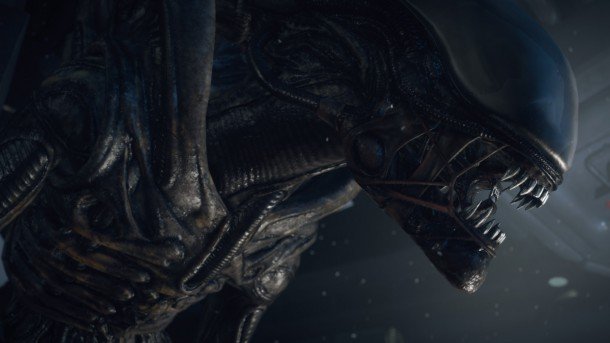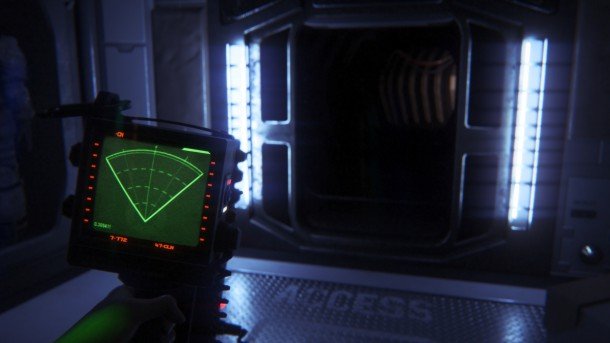Alien: Isolation preview: hands-on with Creative Assembly's ambitious sci-fi horror

'Aliens' is a brilliant name for a movie sequel, when you think about it. It's a one-word pitch: remember that terrifying, implacable, unkillable alien monster? Well, now there are more of them. Let your imagination do the rest.
The trouble comes when the escalation doesn't stop. Almost thirty years after Aliens, Giger's monster isn't scary any more. It's cannon fodder, a fast zombie, a banana-headed moron . Games have finished off what the movies started, completing the xenomorph's transition from unknowable terror to lunchbox mascot. Lunchbox mascots, in the main, are not a credible threat.
I played Alien: Isolation for forty-five minutes, and in that time it did more to rehabilitate the alien in the part of my brain reserved for things that scare the shit out of me than any game since the original Aliens versus Predator. That's the highest praise I have to offer, and more than I'd thought to hope to get out of the reveal of a new Alien game, particularly one from a developer known for grand strategy games and the odd wonky fantasy action title.
But here we are. Creative Assembly have gone and made an Alien game that is actually scary, the game that you have probably been asking for in comments threads since Colonial Marines disintegrated on launch like a crap rocket made of blank cheques and publisher's tears.
There's still time for Alien: Isolation to stumble - I'll get to that later. First, though, I want to explore why the version I played worked as well as it did.
It's an Alien game, not an Aliens game
The key's in the name. Creative Assembly claim to have ignored every development in the franchise that followed Ridley Scott's movie. That means no pulse rifles, no jarheads, no queens, Praetorians, predaliens, and so on. It's an Alien game, and as such it's in competition pretty much exclusively with the (surprisingly excellent) Spectrum RPG from 1984.
You play as Ellen Ripley's daughter, Amanda, fifteen years after her mother blew up the Nostromo and vanished. In Aliens, Ripley wakes up from cryosleep to find that 57 years have passed and Amanda has died of old age; Isolation posits that her daughter spent at least some of that time being chased around a space station by a xenomorph of her own. Creative Assembly have tapped veteran comic book writer Dan Abnett for the story, who you may know from the Warhammer 40,000 novels or his work for Marvel.
Keep up to date with the most important stories and the best deals, as picked by the PC Gamer team.
Haunted by her mother's disappearance, Amanda Ripley joins Weyland-Yutani as an engineer, where she is approached by a company executive claiming to have located the Nostromo's black box recorder on a remote space station called Sevastopol. Amanda signs on with a mission to investigate, but becomes separated from her crew on arrival and finds the station itself in crisis, its surviving population panicked and fighting among itself. Also, there's an alien.

Long-suffering Alien fans will be used to retcons, and while Isolation's plot is a convoluted excuse to call the protagonist 'Ripley' it nonetheless seems well-considered, particularly when compared to the far more egregious trampling of franchise history that Colonial Marines was guilty of. Importantly, the influence of the original film isn't simply in the plot: it's in the way the world is constructed, and the kind of things you're asked to do in it.
When I begin playing Amanda's inventory consists of a hacking tool, a handheld motion tracker, and an adjustable flashlight. I opt to never use the flashlight, ever, on the basis that if an acid-blooded horror wants to murder me I'd rather it didn't know where I was. The motion tracker must be raised by holding a button - there's no HUD - at which point a depth-of-field effect wipes out your peripheral vision. You can look at the tracker or look where you're going, but doing both at once is a challenge.
The first task I'm given is to find a blowtorch to open a locked bulkhead, and it's already scary. The environment is split between well-lit rooms and pitch-black corridors. The space-station groans and creaks constantly, like it's under stress, and a sudden thumping in the pipes above me makes me jump. I opt to crouch and crawl around as slowly as possible, just to be on the safe side.

There are lootable containers stashed away underneath tables and in dark corners, and in these I pick up bits of scrap that hint at a crafting system - not present in the demo, but heavily implied.
Eventually I make my way to a long, horseshoe shaped atrium with a few labs and a power generator. I am under no direct threat that I know of, but I play incredibly cautiously. The trepidation reminds me of playing Amnesia for the first time, knowing that the developers have something nasty planned but not knowing when or how it'll make itself known. As in that game, I take note of anywhere I might later hide - in this case, lockers dotted around the outer wall that I can leap into if I need to.
I power up the generators and run to complete my objective, which is to extract some information from a computer. Hacking it involves a minigame where, after dialing in the correct frequency - think Arkham Asylum's similar system - you have to match a geometric shape by keying in its component parts. It's a little gamey, but far less than hacking games tend to be. It's no Bioshock Pipe Dream, for one thing.
Then, the alien shows up.
Joining in 2011, Chris made his start with PC Gamer turning beautiful trees into magazines, first as a writer and later as deputy editor. Once PCG's reluctant MMO champion , his discovery of Dota 2 in 2012 led him to much darker, stranger places. In 2015, Chris became the editor of PC Gamer Pro, overseeing our online coverage of competitive gaming and esports. He left in 2017, and can be now found making games and recording the Crate & Crowbar podcast.


